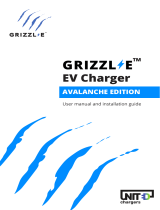
14
Attention
Lire toutes les instructions avant d’uti-
liser ce produit.
Toujours couper l’alimentation prin-
cipale du DCC - Contrôleur de charge
pour véhicules électriques avant toute
manipulation.
Utiliser le DCC - Contrôleur de charge
pour véhicules électriques uniquement
en respectant les spécifications tech-
niques indiquées dans le présent ma-
nuel d’installation.
Ne pas installer le DCC - Contrôleur
de charge pour véhicules électriques à
proximité de matériaux inflammables,
explosifs ou combustibles, produits
chimiques, et des vapeurs.
Ne jamais asperger le DCC - Contrôleur
de charge pour véhicules électriques
d’eau ou de toutes autres liquides.
Arrêtez d’utiliser immédiatement le DCC
- Contrôleur de charge pour véhicules
électriques s’il est défectueux, craqué,
brisé ou endommagé.
Ne jamais essayer de modifier, de
réparer ou de désassembler le DCC -
Contrôleur de charge pour véhicules
électriques. Veuillez contacter le manu-
facturier pour toutes défectuosités.
Ne jamais insérer d’objet coupant à l’in-
térieur du DCC - Contrôleur de charge
pour véhicules électriques sous risque
d’endommager les composantes.
Un usage inapproprié du DCC - Contrô-
leur de charge pour véhicules élec-
triques peut entraîner des risques de
blessures graves pouvant causer la
mort.
Pour une installation verticale sur un
mur, vous référer aux indications sur le
boitier pour le choix de l’orientation.
Précautions
Un usage inapproprié du DCC - Contrô-
leur de charge pour véhicules élec-
triques peut entraîner le bris et l’usure
prématurée des composantes, ce qui
annule toute garantie.
Ne jamais utiliser le DCC - Contrôleur de
charge pour véhicules électriques dans
des températures en dehors de -22°F à
113°F (-30°C à 45°C).
Toujours entreposer le DCC - Contrôleur
de charge pour véhicules électriques
dans des températures supérieures ou
inférieures de -4°F à 158°F (-20°C à
-70°C).
Procéder à l’installation du DCC -
Contrôleur de charge pour véhicules
électriques en respectant le code élec-
trique en vigueur.
Notes
Il est préférable de programmer la re-
charge du véhicule électrique durant les
heures de faible consommation d’élec-
tricité afin de minimiser les interruptions
de la borne de recharge du véhicule
électrique.
Toujours vérifier que le DCC - Contrôleur
de charge pour véhicules électriques est
fixé adéquatement au mur ou au plafond
et qu’il est situé dans un endroit où il
n’est pas à risque d’être endommagé.
Même si ce produit a été conçu pour les
bornes de recharge pour véhicules élec-
triques, il peut être installé avec d'autres
types de charge.
Il est de la responsabilité de l’installa-
teur de s’assurer que la source d’ali-
mentation électrique soit suffisante
pour permettre l’utilisation d’un ou de
plusieurs DCC- Contrôleur de charge
pour véhicules électriques.
Ne pas utiliser de solvants de nettoyage
pour nettoyer le DCC - Contrôleur de
charge pour véhicules électriques.
Garantie Limitée
1 THERMOLEC LTÉE. garantit contre tout
défaut sur les contrôles intégrés pour
un an à partir de la date de livraison.
La garantie est limitée à l’équipement
et aux composants fournis par THER-
MOLEC LTÉE.
2 En cas d’installation non conforme,
de mauvais usage ou de réparation
par du personnel non autorisé par
THERMOLEC LTÉE., la garantie s’annule
automatiquement.
3 THERMOLEC LTÉE. s’engage à réparer
ou à remplacer, au chantier ou à son
usine selon son choix, la marchandise
qui à l’examen fait par son représen-
tant se sera avérée défectueuse.
4 THERMOLEC LTÉE. ne sera pas tenue
responsable de dommages ou délais
et ne sera pas tenue de payer des frais
occasionnés par le déplacement du
contrôleur de charge dit défectueux.
5 THERMOLEC LTÉE. ne devra pas être te-
nue responsable des dommages indi-
rects ou des délais occasionnés par un
défaut de main-d’œuvre ou de matériel.
Aucune indemnité ne sera accordée
pour réparations, remplacements
ou modifications si une autorisation
écrite préalable n’a pas été fournie
par THERMOLEC LTÉE.
6 Tout dispositif de commande ou ac-
cessoire fourni avec le DCC - Contrô-
leur de charge pour véhicules élec-
triques pour être monté ou raccordé à
distance du contrôleur de charge sera
garanti par le fabricant seulement
sous réserve des conditions précitées
au paragraphe 5.
7 Les composants fournis pour des
réparations sont garantis pour la ba-
lance de la durée de la garantie sur le
produit original ou 90 jours. La plus
longue des deux durées sera retenue.
8 Toutes réparations complétées à l’usine
THERMOLEC LTÉE. après la période de
garantie sont garanties pour 30 jours à
partir de la date de réparation.
INFORMATION DE SÉCURITÉ
Ce document contient des instructions importantes de sécurité qui
doivent être suivies durant l’installation, la maintenance et l’utilisation
du DCC - Contrôleur de charge pour véhicules électriques.





















